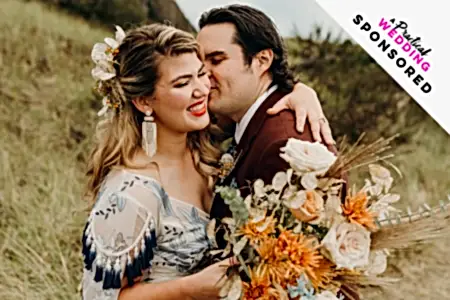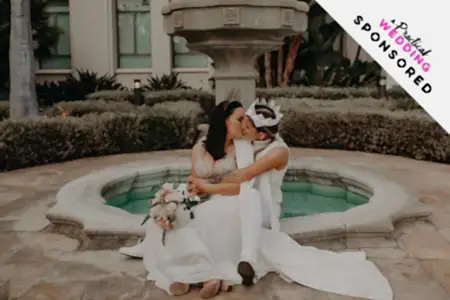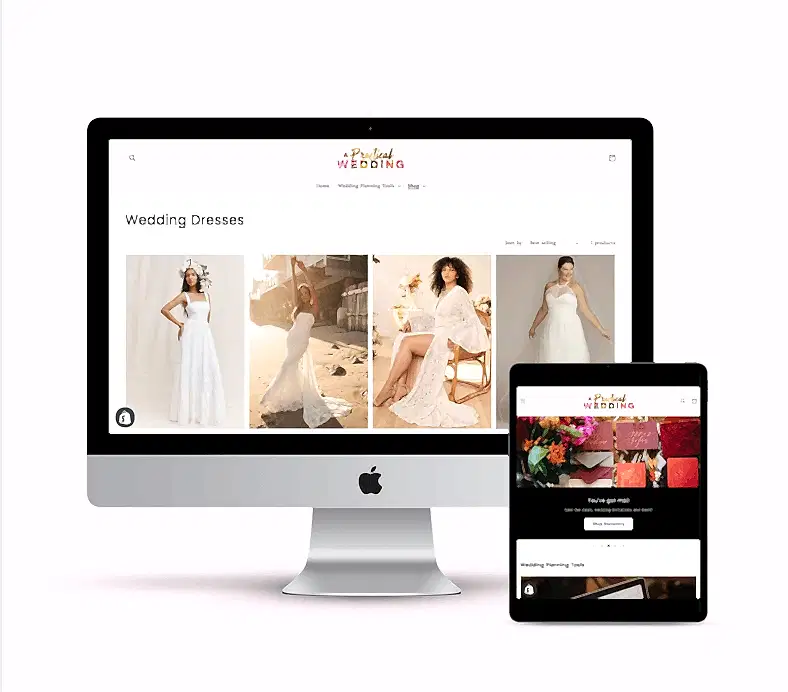You’ve probably never used a wedding alcohol calculator before. Because buying booze for a small gathering is one thing, but what about for a hundred people, one of whom is your Nana? No? Well, here’s everything you need to know about how to buy alcohol for your wedding. (Note: remember to buy ice).
Know Your Crowd (Before you Hit Your Alcohol Calculator)
Before we dive in, let’s preface this information with a note that only you know your crowd. I spoke with Nicky Beyries, Bar Director at Foreign Cinema and Laszlo in San Francisco, who has over five years of experience overseeing events, to get some advice on how to approach buying booze for your wedding. She emphasized the importance of knowing your people.
“First, take an honest and legitimate inventory of your wedding attendees. Honesty is key here—some wedding attendees drink almost nothing, others drink a lot. Any insight you can offer is helpful; if your crowd loves red wine or Bud Lite or fancy bourbon, if Uncle Tommy loves his Chardonnay at a particular temperature, these are all things to plan ahead for.”
If half your guests don’t drink, adjust accordingly. If your loved ones drink beer, but hate wine, well, don’t have a wine-only reception. Also, take your region of the country (or hell, your country) into account. At the end of the day, you know best what your loved ones expect and what you care about.
This is a guide to best practices and general wisdom, with some help around the math with an actual wedding alcohol calculator, but it’s designed to help you adapt as you see fit. We’ve also put together a downloadable checklist for your wedding bar (below) that you can print out and take to the store to make sure you don’t forget anything (including ice!)
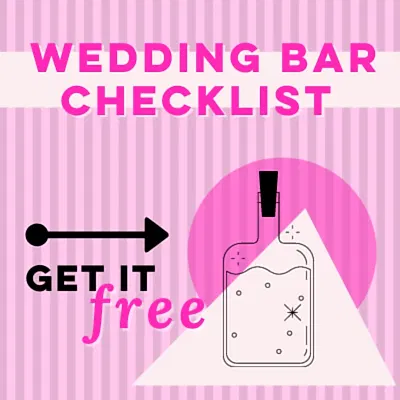
What Are Your Expectations?
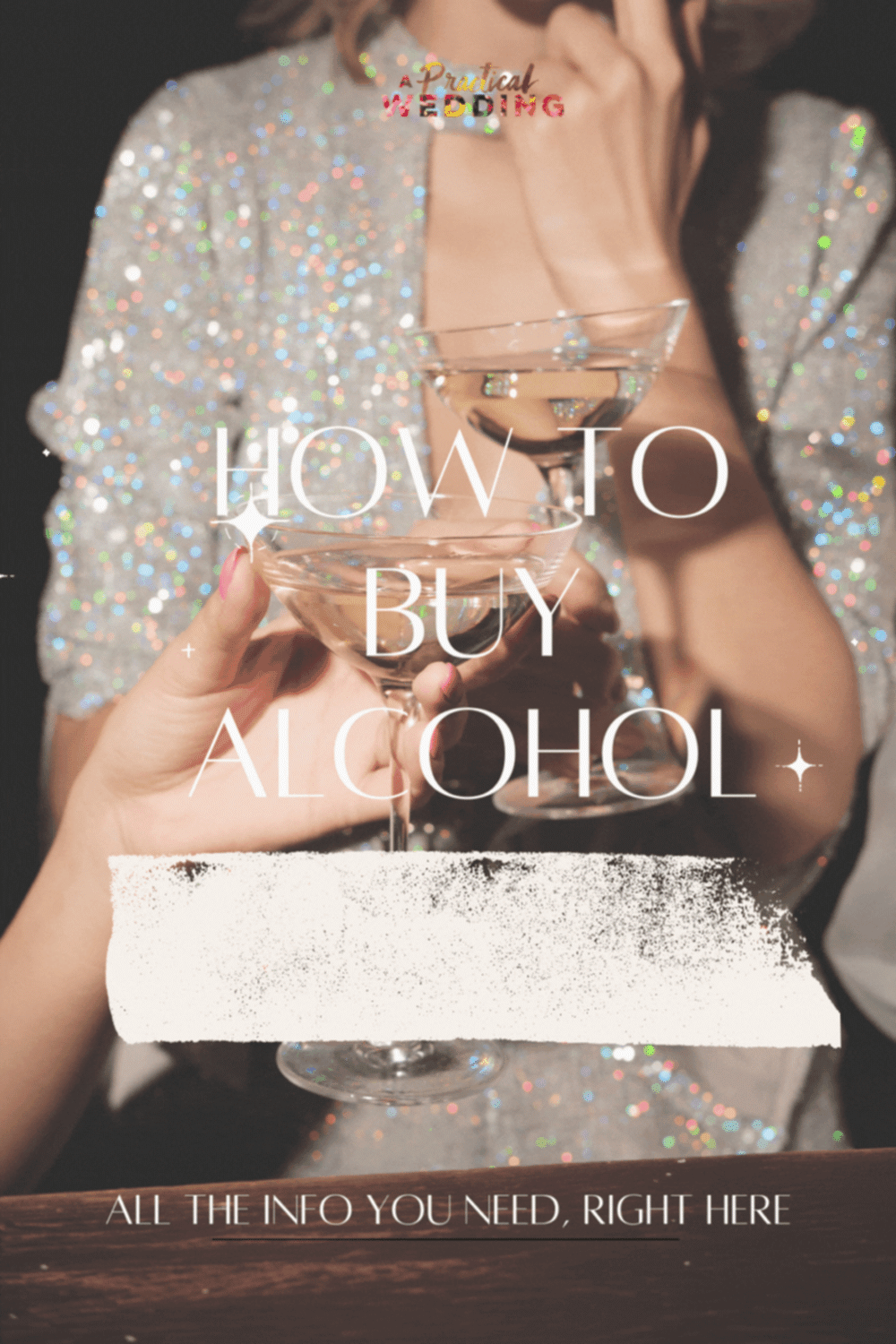
It’s also good to check in about your own expectations around a wedding, and specifically, think about if (and when) you’re willing to run out of alcohol. I spoke with Chase Daley of Bar Baby Co., a mobile bar specializing in custom signature cocktails at weddings and events in Sacramento, California, and he said each host has a different relationship to running out.
“Some people like to run out towards the end, and some people never ever want to run out, and that’s an important part of how you round up or down when figuring out how much to buy.”
You may decide that running out of booze is your worst nightmare and you’d rather have leftovers to enjoy on your (tenth!) anniversary, or you may decide that running out of things towards the end of the night is no big deal.
How Do I Buy ALCOHOL For My Wedding? (And can You Hit Me With A Wedding Alcohol Calculator)
You Can’t DIY a Full Bar
There are three basic types of wedding bars:
- Beer and Wine only
- Full Bar
- And the something-in-between I’ll call modified full bar
If you are set on doing a true full bar, like the kind you have at an actual bar, I do not recommend going our DIY route.
Chase Osthimer, an events ambassador for Lo-Fi Aperitifs and Quaker City Mercantile in California and Pennsylvania, says that “It’s easy to get bogged down in feeling like you have to offer everything, and that’s just not true. I’m a big fan of picking a few things to do, and do those things well—I think ultimately, guests feel more taken care of that way, and you can serve things well, not haphazardly.” No alcohol calculator is gonna work for a bar that involves twenty kinds of booze. Work with a professional bartending service and your venue, unless you want to blow most of your budget on half the stock at your local liquor store.
This tutorial is all about the modified full bar and the beer and wine only bar. So if you’re wondering how to figure out how much alcohol you should have at your wedding, here are the steps.
Decide What You’re Serving
On the West Coast, a beer and wine only wedding is usually completely acceptable, especially if you also decide to offer a signature big batch cocktail or two, in addition, a few craft beers, or a selection of wines. On the East Coast, however, you may find the expectation is that there will be a full bar, or at least a modified full bar, and other regions of the country also have their own expectations around what will be served.
Here at APW, we’re big fans of the “do what works for you” school of thought, though, so take that generalization with a salted rim. As Nicky Beyries notes, “I think a beer and wine only bar can work really well for a wedding. If you choose to only offer beer and wine, it’s often much less complicated to navigate your venue’s rules and local liquor laws. I think it is more important to make sure that one, you have solid, easily accessible and recognizable options and, two, that you stock up more on each individual option. I have found that four distinct options is the sweet spot in either category: four beers and four wines,” so consider an array of choices if you’re not also offering hard liquor. Regardless, before you dive into calculations, decide what you actually want to serve to your guests, and then build out your plan from there, starting with our wedding alcohol calculator.
Stock Your Bar
You don’t need every mixer under the sun, or every booze known to man. Here’s what you want to make sure you have:
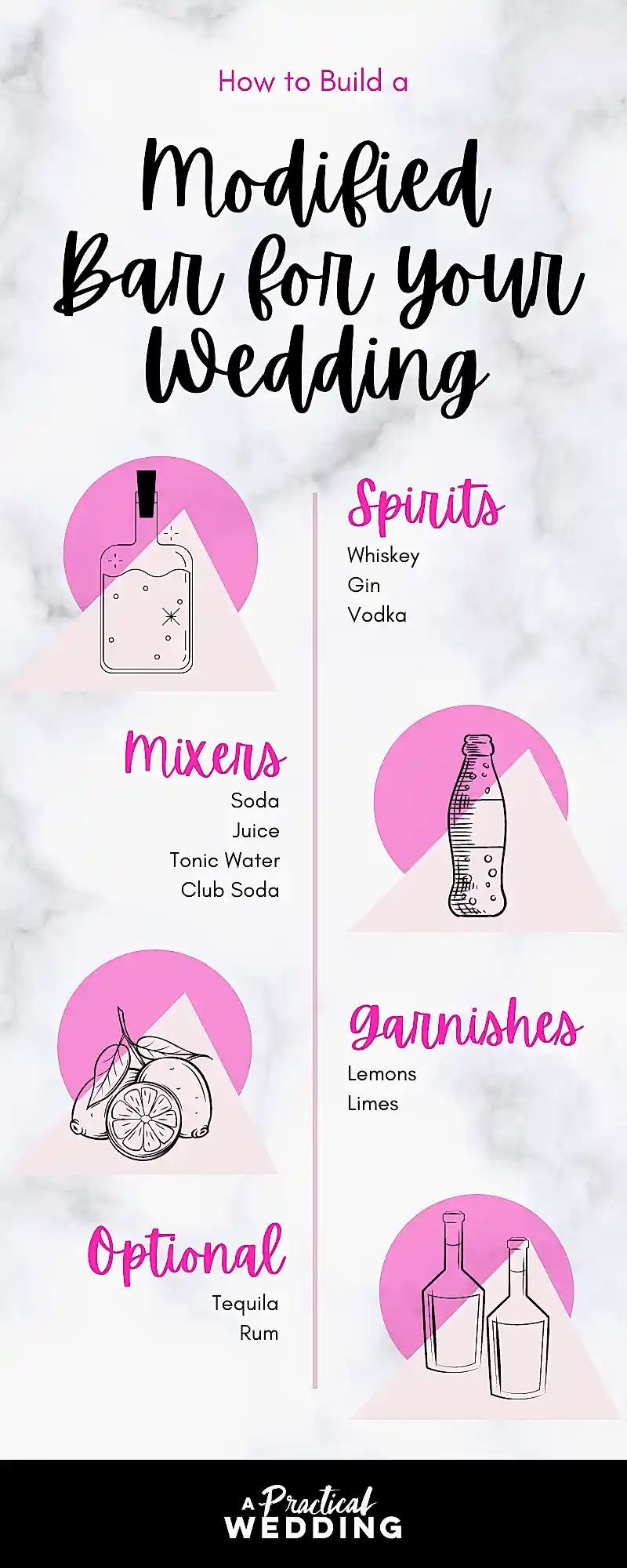
When picking alcohol to stock your bar, know your crowd. If your family is definitely going to want to hit the tequila, make sure you have tequila, plenty of limes, and salt on hand. A serious crowd of whiskey drinkers? Great, make sure to have more of that. And then, of course, you’ll need beer and wine for both a modified full bar or for a beer and wine only bar.
Modified Full Bar
Booze: Whiskey, gin, and vodka
Optional Booze: Rum and tequila (though these days, Gin might be optional and tequila might be required. But again, know your crowd.)
Mixers: Juice (usually orange or cranberry), soda (at least a cola), tonic water, and club soda
Garnishes: Lemons and limes
Beer and Wine Bar (And modified FULL bar)
Beer: It’s nice to select at least two types of beer to provide options; if you’re only offering beer and wine, Nicky Beyries recommends thinking about as many as four choices for variety, “Say, a pilsner, an amber, an IPA and a darker beer, whether a stout or a black lager.” You will also need to consider bottles versus a keg. Bottles can be more expensive, and some people feel the beer doesn’t taste as fresh. However, kegs require a tap system (either a pony keg or tap), which you’ll need to rent from the liquor store where you bought the keg. Also, keg leftovers are much harder to deal with and don’t keep for more than a day or two. As Nicky Beyries says, “I cannot recommend bottled and canned beer over kegged beer enough, it makes managing leftovers so much easier.”
Wine: You’ll need at least one red wine and one white, but you don’t need more than one varietal (or blend) of each, unless you want to have them. If you’re only serving beer and wine, it is nice to consider a few additional options; Nicky Beyries recommends “a sparkling, a white, a rosé, a red, or if you’re a wine-savvy group, add an additional white and an additional red.” Chase Osthimer notes that if you do decide to offer two reds or whites, make sure they are distinct. “A full-bodied cabernet sauvignon and a lighter pinot noir will work well together, just as a fuller chardonnay and a brighter sauvignon blanc will if you’re doing white wine.”
Bubbles (Optional): Cava from Spain, Prosecco from Italy, and sparkling wine from other non-Champagne regions are delicious, and they are almost always a better deal than French Champagne. If you’re going to serve bubbles as a toasting-only option, you want about 4–5 ounces per person, per toast. Also, you don’t have to do a bubbly toast, if you don’t want to. People can cheers with anything, and your marriage will still be official. Promise.
Use a Wedding Alcohol Calculator
In order to figure out how much to buy, you can easily do some simple math (see the infographic below), or use a handy wedding alcohol calculator. We like this one, from Hubtap.

KNOW YOUR CROWD
Do these wedding alcohol calculator ratios look off to you? Is your entire extended family comprised of people who exclusively drink beer, forever and always? Adjust for that! These ratios are a starting point, and won’t work for every group gathering. Here’s an example from a former APW staff member’s wedding.
Our friends and family are almost entirely beer or hard liquor drinkers. So for fifty people for two nights of drinking, we bought two kegs of beer, ten-ish bottles of liquor (not including liquor bought and brought by friends and family), and maybe three cases of wine. We had a case of leftover wine from the wedding on Sunday morning. The beer and liquor? Polished off by about 10PM on the second evening, a couple hours after our “official” wedding end time.
remember your time and location When Using your Wedding Alcohol Calculator
Generally, people will probably drink a little less at daytime weddings, so round down your numbers for a brunch or daytime wedding. Get one case less than the wedding alcohol calculator says to. Think about where you’ll be, when, and what the weather will be like when you are figuring out how much to get of each kind of alcohol. Think about what you would like to drink, and remember to consider your audience. During the summer, people will drink more chilled white or rosé wine, light beer, and bubbly, but in cold weather, more red wine and darker beers.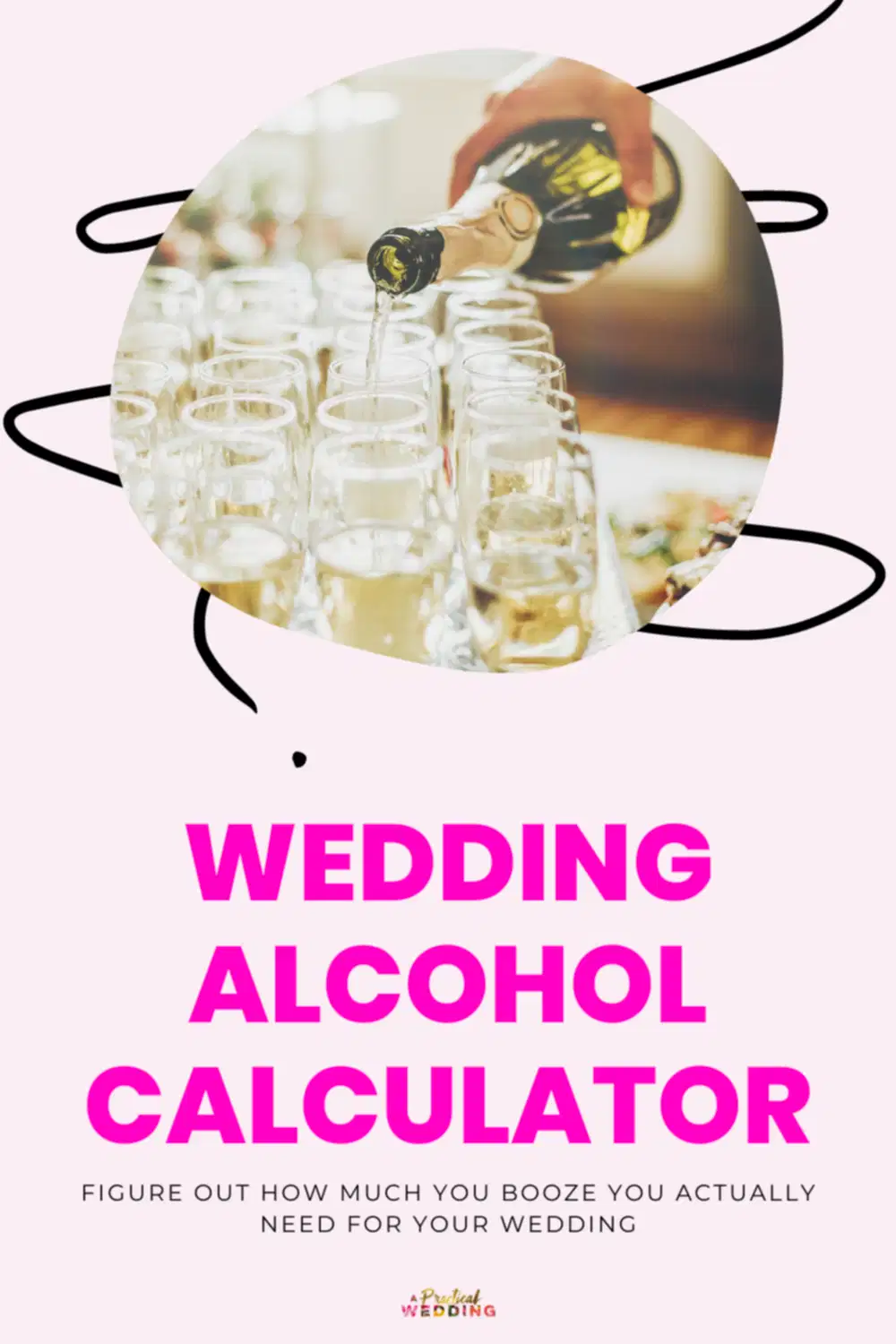
Some notes About Glassware
Size Matters
One thing to be aware of when selecting your glassware is how much a serving size really is, and what that will look like in the glasses you are using. Large glasses will encourage large servings, and that also goes for mason jars, most of which are a full pint. As Nickey Beyries notes, “There is a definitive trend for gigantic glasses lately. A two-ounce pour of whiskey (already generous) in a huge ten-ounce double rocks glass looks very, very small, so guests complain and bartenders over-pour to compensate. It creates a visual that can look stingy on the part of the hosts, even when it’s not at all! A full margarita would look small in that glass! Small, classy glassware is everyone’s friend, as it makes it seem like the staff are pouring generously and helps prevent guests from over-imbibing.” This is doubly true if your bar is self-serve, and if your bartender isn’t a pro. Wine glasses can run anywhere from eight to twenty ounces on average (the estimate of four glasses per bottle in the infographic equals about six ounces per serving, so keep that in mind).
Rentals, Disposables, Oh My
For everything you need to know about rentals, this is a great place to start. For your bar specifically, don’t stress out too much about a ton of different glasses. Nicky Beyries recommends “A full bar needs rocks glasses, a soda glass (just use a pint to double for folks that want a cold beer glass), and a wine glass. It’s very ‘in vogue’ to use a white wine glass for sparkling wines due to better effervescence, so you could easily just have a single all-purpose wine glass for all your wine selections.” For beer and wine only, one wine glass style and one beer glass are perfectly acceptable. If you’re doing disposables, compostable glassware is an easy, somewhat eco-friendly option. You can also try giving all your guests one glass, and encouraging them to use it for the whole party. If you do want to go this route, consider a creative way to mark each guests glasses as their own. (Or you know, kick it old school with red cups and a sharpie.)
discuss Signature Cocktails
If you are doing a signature cocktail, subtract one hour from your calculations. During cocktail hour, assume everyone’s drink will be the signature one, and make sure there’s enough for everyone to have it. Then, proceed with the numbers above, and calculate your signature drink separately. This works with either type of bar. Chase Daley, who specializes in signature cocktails, says “We typically create one cocktail inspired by each member of the couple. I always suggest something that will cover a wide spectrum: one clear spirit and one dark spirit, so you have variety.” For everything you need to know about batching cocktails, head right here, and for cocktail recipes designed for batching, consider this excellent book that you’ll be glad to reach for every time you throw a party (hint: it also makes a great gift).
(Non) Alcohol Calculator: For Kids and former bartenders
Every expert I talked to had strong opinions on making sure there were good non-alcoholic options, starting with offering plenty of water at self-serve stations. As Chase Osthimer notes, “Always always have water available for people to help themselves, preferably at more than one station. If people have to come to the bar for water, they get grumpy, the lines get long, the bartenders get backed up, and it’s really just a whole mess that can be easily solved with a simple drink dispenser and a stack of glasses.” Increasingly delicious non-alcoholic beverages are available, too, and it’s always nice to provide something for those who aren’t drinking. Nicky Beyries says “Non-alcoholic beverages are very, very popular, especially in the context of family gatherings such as weddings. I love to make fun non-alcoholic drinks and I take great joy in finding everyone something they can enjoy,” so don’t hesitate to talk to your bartender about figuring out a fun non-alcoholic option. Fancy sodas and flavored seltzer are everywhere now, and so great for people who don’t drink or people who just want to pace themselves. As far as the math, container sizes can vary so we couldn’t include them in our wedding alcohol calculator, but in general, aim for the same number of servings as you are getting for beer.
Communication is Key
It’s not as simple as using an alcohol calculator and calling it a day. Everyone I talked to also stressed the importance of communication between your bar staff, catering staff, and day-of coordinator. Chase Osthimer says that “There is really no such thing as over-communicating here. Put your caterer, bartenders, and planner in touch ahead of the event, since they will have a lot of things to work out that will make the day go much more smoothly.” Nicky Beyries agrees, and notes that a lot of coordination with catering can save time and make sure your guests get what they want. “Due to potential disconnects between the bar service and the catering staff, we don’t always know where to find the iced tea or what sort of coffee is available. I’m a huge fan of beverage stations—say, a coffee and tea station, multiple water stations, maybe a mocktail station, and any decent catering service would be happy to help you arrange for those. It’s about ensuring that you have a stress-free day and that all your guests can find something they will enjoy quickly.” Another moment when this kind of communication is key is during any toasts you may have planned. Chase Osthimer notes that “everyone, of course, will want to make sure they have a glass of something to toast with, so make sure your bartenders have a heads up from your planner or DJ so they can plan accordingly for a bar rush.”
get liability insurance (if you need it)
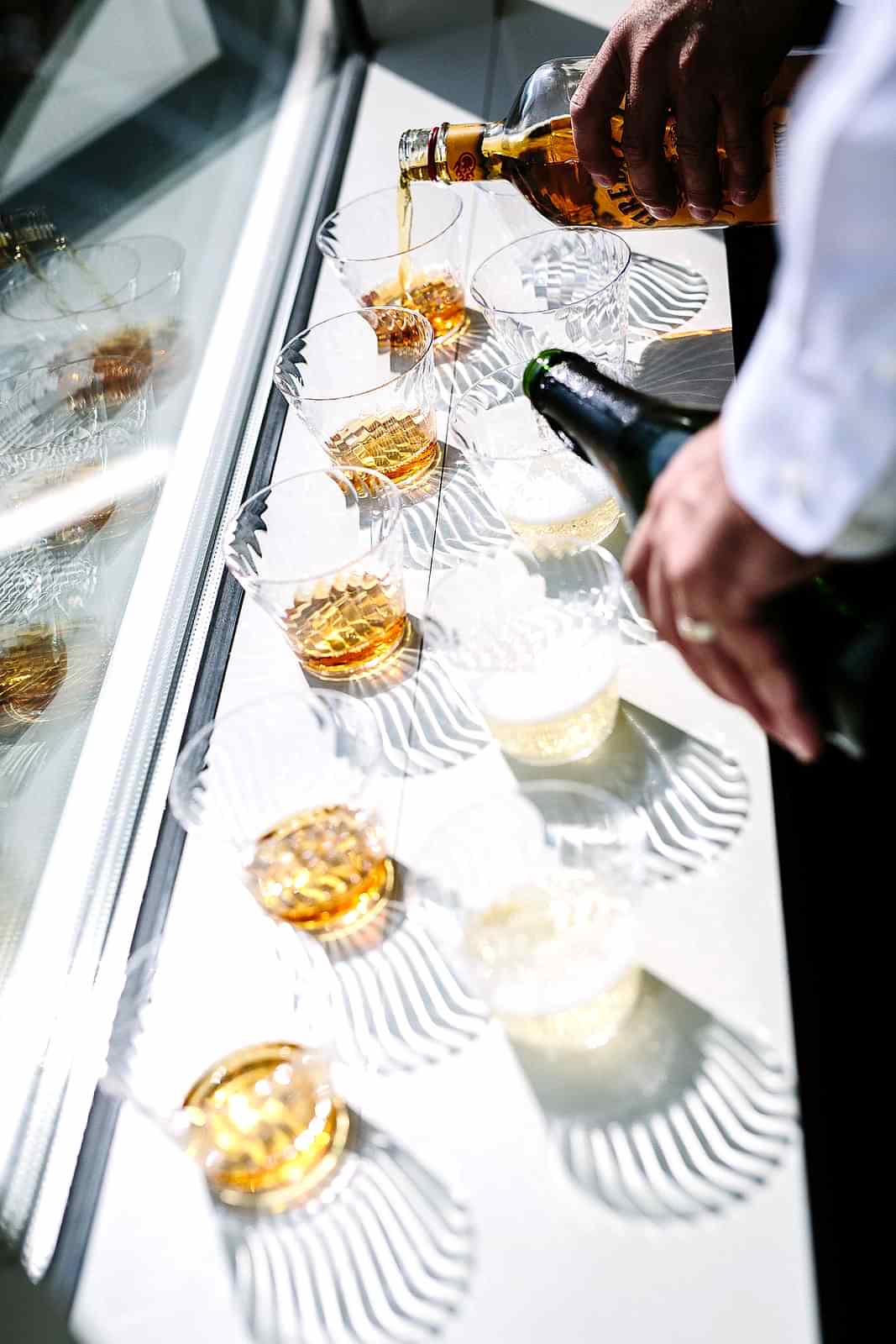
If you’re providing your own alcohol, you’re likely not going to be covered by your caterer’s liquor liability policy. No one likes to think or talk about the potential for alcohol-related incidents, especially not at a wedding. However, if you’re serving people drinks and something awful happens, sadly, you could be on the line. If someone crashes a car, falls off a balcony, or damages the property, or if that underage third cousin sneaks some drinks and gets sick, etc., the hosts could be held liable. It’s terrible to think about it, but even worse to get sued. If the couple or parents are homeowners, they can usually put a rider on their homeowner’s policy for the event. Otherwise, there are tons of insurance companies that specialize in event insurance. (And note: plenty of people on staff have served booze at their wedding without insurance. But do as we say here, not as we did.)
know your dram laws and state liquor laws
State liquor laws are archaic, and sometimes very strange. For example, it’s illegal to return alcohol in California (I found this out the hard/awesome way and have the cases of leftover bubbly to prove it), and in some states, you can’t buy alcohol on Sundays. Dram Laws also vary by state and determine who can be held liable in case of an accident. Because we can’t possibly predict what problems you can run into in each state, here is a website where you can check your state’s Dram Laws and make sure you have the necessary information.
What type of wedding alcohol calculator did you use? Did you get it right, run out, or have many cases of booze left over?








